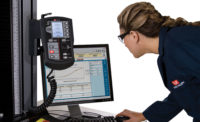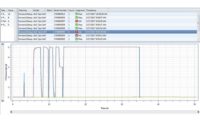When should product wear be simulated and when should it be stimulated?
Environmental testing is divided into natural or climatic environments, which include sunshine, rainfall, wind, altitude and salt spray, vs. man-made or dynamic environments such as vibration and shock. Vibration testing, particularly on random vibration, is one of the most important and revealing environmental tests available to manufacturers.
Vibration testing includes the simulation of real-world vibrations as in an environmental test lab and stimulation tools such as preproduction highly accelerated life testing (HALT), post-production environmental stress screening (ESS); and post-production highly accelerated stress screening (HASS). The HALT, ESS and HASS tests are stimulation tools that are intended to cause weak products to fail.
Failures and reliability
As long as a product's strength is greater than the loads it will encounter, failures will not occur. This, however, is overly simplistic.
In the real world, strength varies between individual products. A bell-shaped distribution is the result. A few individual products will be extra-strong. A few will be extra-weak.
Loads will also vary and result in a bell-shaped distribution. A few loads will be extra-severe. A few will be extra-gentle.
So, two distributions are common, one for strength and one for load. As long as the strength is greater than the load and the two distribution curves are separated, and, as long as the weakest product is stronger than the greatest load, the equipment will be reliable and failures will not occur.
A problem that often occurs is that products weaken over time, so that an occasional maximum load will exceed the least strength, and some failures will result. Factors that can cause a weakening or loss of strength over time includes aging and fatigue. Whatever the reason, the strength distribution shifts to the left, and failures occur.
A downside of high electronic equipment reliability is that ordinary reliability tests have become long and expensive because it takes that much longer for the product to fail. Without HALT, manufacturers might have to wait, possibly for years, for the strength-reducing effects of aging to be made clear. Instead, test loads can be applied at greater than normal and any failures can be observed. For each failure, the root cause needs to be identified and corrected to improve the strength of that product.
Ultimately, the accelerated tests will reach hard limits that would require excessive and impractical redesign effort. These are called destruct limits.
The HALT test, which reveals the effects of aging, can be used to help find these limits. The purpose of HALT is to cause prototype products to fail-not destroy prototypes, but identify one at a time each possible way in which a prototype product can fail. The tester will want to identify, understand and correct each possible failure mode. Most such corrections are relatively cheap to fix, at this stage; later (after production begins or, worse, after products have reached customers) they would be hundreds or thousands times more expensive to fix. A secondary purpose of HALT is to identify stresses that are appropriate for post-production ESS and HASS testing.
Accelerated testing provides a way to reduce test time by conducting tests at stress levels greater than operational levels. Thermal cycling and random vibration are the tools most used to accelerate failure mechanisms.
HALT testing has just two rules: the goal is to improve a product's reliability and therefore there are no absolute stress levels that the tested unit must pass; and, HALT units should never be shipped to a customer.
Periodic vs. random vibration
Vibration is often divided into periodic or repetitive vibration, whereby failure can be predicted if past behavior is known, vs. aperiodic or non-repetitive, random vibration. Random vibration cannot be predicted in detail, but some statistical behavior is often possible. Sine vibration, which is a single-frequency-at-a-time example of periodic vibration, is often used by test labs to identify resonances and to focus redesign to lessen resonant damage. Random vibration often better simulates the real world. This is particularly true when applied to electronic assemblies. In this application, random vibration is often combined with rapid temperature cycles that cause rapid expansion and contraction of parts and assemblies to make detectable existing latent defects into observable defects. Then the defects can be identified and design or manufacturing changes can be made that can prevent their recurrence in future production cycles.
Outside the test lab, in the real world, the sources of unpredictable random vibration are abundant. Sources range from rocketry, during which the combustion and turbulent air motion during high speed flight is random, to earthquakes. In between, is the more familiar example of roadway inputs to automobiles, trucks and buses.
Environmental test usually simulates
For perhaps 50 years, military services and other users of complex systems have measured climatic conditions worldwide. They measured the vibration and mechanical shock environments aboard their vehicles and have asked their suppliers to do environmental qualification and acceptance tests that attempt to simulate, and perhaps to exceed, those in-
service conditions. The military engineers and inspectors hope that a product's survival in a test chambers, on shakers and on shock test machines, can guarantee survival in service. By and large, these hopes have been fulfilled.
Reliabilities, and warranty periods, have increased. However, some systems have been plagued with intermittent faults. These faults can be analyzed on the same chambers and shakers that perform climatic and dynamic environmental tests for HALT, ESS and HASS stimulation, but more effective and less expensive alternatives are available.
The trend today is to stimulate the product. This is especially true for commercial off-the-shelf products. Whether the military buys these products should not be a huge motivator. Manufacturers of commercial and personal equipment should want their products to be reliable.
Random vibration stimulus is familiar to those who are aware of thermal stressing and its effects. Note that today's temperature ramping rates are much faster than in previous years.
Whereas a swept-sine vibration test sequentially excites resonances, broad-spectrum random vibration testing simultaneously excites those same resonances, leading to the discovery of more of the existing weaknesses.
Multiaxis stimulation more effective
Conventional vibration testing uses an electrodynamic single-axis-at-a-time shaker. The X axis of the product being tested is aligned with the shaker axis. Then the product is reattached with its Y and finally its Z axis aligned with the shaker axis. This has been acceptable since the mechanical shakers of the early 20th century, but this is not realistic. In the real world, dynamic environments include X inputs, Y inputs and Z inputs plus roll, pitch and yaw inputs. Multiaxis shaking reveals additional product weaknesses.Instead of a multiaxis machine, multiple single-axis shakers, all highly controllable, could be used. For most manufacturers, however, they would be prohibitively expensive and only the military can afford them.
What about pneumatic vibrators?
Consider instead performing HALT, ESS or HASS on an array of unsynchronized shop-air-driven repetitive shock devices, all pointed upward along different compass headings into a softly-sprung platform. Visualize that platform responding in six axes. That platform acts as the bottom side of a temperature chamber. Products under test, attached to the top of the platform, experience rapid thermal ramping plus multiaxis vibration.
All the units under test are powered and are functionally monitored. Specialized circuitry detects and records any intermittent behavior, any momentary or permanent misoperation. Questionable units are removed for possible repair or for scrapping. They don't go to final assembly and they never reach the customer. Q
Sidebar: Tech tips
• Environmental testing is divided into natural orclimatic environments and man-made or dynamic environments.
• Vibration testing, particularly random vibration, is one of the most important and revealing environmental tests available to manufacturers.
• Vibration testing includes the simulation of real-world vibrations, and stimulation tools such as HALT, ESS and HASS.
Sidebar: Acronyms
• HALT preproduction highly accelerated life testing.• ESS post-production environmental stress screening.
• HASS post-production highly accelerated stress screening.
• COTS commercial, off-the-shelf, non-developmental products, increasingly being purchased by the military services.





